
The IS-7 (ИC-7), starting life under the project title of Object 260 (объект 260), followed on from the ill-fated IS-5 (Object 730) and IS-6 (Object 252/253). With these failures, the request was still standing for the USSR’s next heavy tank.
The IS-7 was the brain-child of the Soviet tank designer Nikolai Fedorovich Shashmurin. As well as having a hand in the design of the rather successful IS-2 which would serve well in the later years of World War II, Shashmurin also drew up plans for the ill-fated KV-4 (Object 906) project, which never came to fruition.
The IS-7 would be Shashmurin’s crowning glory and could be considered the zenith of the Iosif Stalin heavy tanks. At the time of its conception, it was one of the most technologically advanced heavy tanks in the world, and one of the most heavily armored.
Design
The seeds of the IS-7 were first sown in December 1945 in Factory No. 100 in Leningrad, with a full-scale wooden mock-up produced soon after. Running prototypes were ready for testing in 1946. These tests ran through 1947, ending in 1948 when the designers believed they had reached a finalized design. It was then given the title of IS-7. This final design was armed with a stabilized 130 mm (5.12 in) cannon fed by an autoloader, a total of 8 machine guns, infrared scopes, and armor up to 300 mm (11.8 in) thick. It was the largest tank that the USSR had or would ever produce.
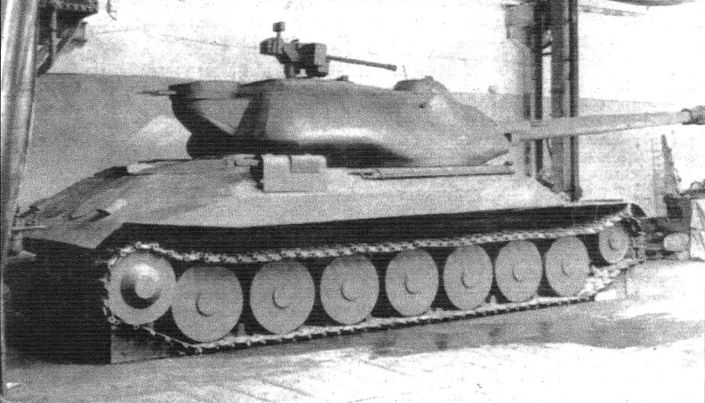
The wooden mockup of the IS-7, at this point known as the Object 260
Armor
The tank was designed to withstand the impact of a shell fired by the 12.8 cm Pak 44 Gun found on the German Jagdtiger. The armor on the IS-7 was up to 300 mm (11.8 in) thick, some of the thickest being found on the specific pike nose, formed from homogenous steel. The upper plates were 150 mm (5.9 in) thick angled at 60 degrees. The lower glacis 100-120 mm (3.94-4.72 in) with a slight angle.
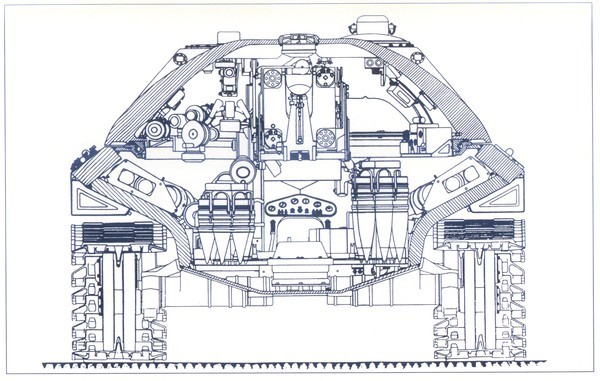
Rear cutaway view of the IS-7. Note the thicknesses of the armor on the turret and hull sides.
The side armor was also not to be underestimated. The upper hull was 150 mm (5.9 in) thick, while the lower sides measured 100 mm (3.94 in) and was curved outwards, meeting the upper hull seamlessly. The bending of the lower hull was done in a large press, which literally forced the metal into shape.
The mantlet was 350 mm (13.8 in) thick. The turret itself was cast, with the cheeks being the thickest part at 240-250 mm (9.45-9.84 in). They were angled, or curved, at about 50-60 degrees. The shape of the turret was extremely rounded and smooth all the way around, with no obvious shot traps or prominent cupola. There were slightly raised portions of the turret roof where crew positions were found. The commander’s station on the right was slightly higher than the gunner’s one found on the left. The top of these raised portions had direct vision blocks.
In a hull-down position, the turret would have been almost impenetrable. The armor proved not only immune to the intended 12.8 cm, but also the tank’s own 130 mm cannon.
Armament
The IS-7’s main armament consisted of the 130mm (5.11 in) S-70, although it was originally intended to carry the S-26. The S-70 was derived from a naval gun. It had a barrel length of 54 calibers. The gun could fire a 33.4 kg shell at 900 m/s and was able to penetrate up to 163 mm (6.4 in) of armor, sloped at 30 degrees, at ranges up to 2000 meters.
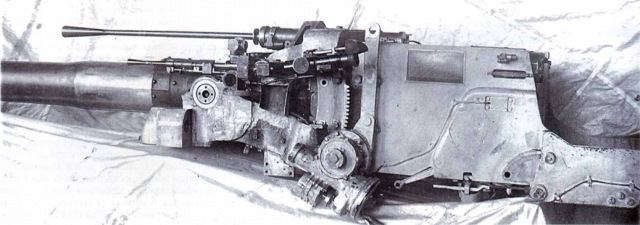
The 130 mm S-70 gun with the coaxial KVPT on top.
As mentioned above, the IS-7 was equipped with an autoloader. It is not an autoloader in the current sense of the word, however. A more accurate description would be an Automatic Loading Assistance Device, that would be operated by the tank’s two loaders. This piece of equipment was located in the turret bustle. The ammunition of the IS-7 was composed of two parts, separately loaded. As such, the charge was at the bottom of the device, while the projectile sat above. It was operated by a crank handle. The first turn would drop a projectile onto the conveyor belt located in the center of the system, a few more turns would drop the propellant behind. The conveyor would then carry the ammunition to the mouth of the breach, where it would be rammed in. The conveyor would then lift clear of the gun. The gun then fired and the process began again.
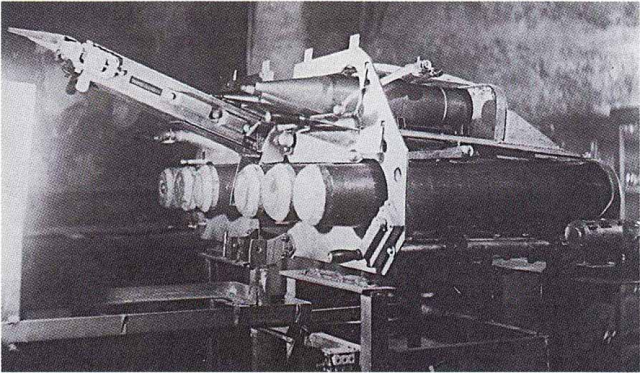
The IS-7s loading system.
This theoretically gave the tank a 6 to 8 rounds per minute rate of fire. Whether actual operation matched this time is unknown, as it doesn’t take into account the reloading of the device. However, it could technically be resupplied as it worked from the various ammunition racks inside the vehicle. The tank carried 25-30 rounds. The downside of this system was that the gun had to return to a neutral position for the loading device to work, meaning the gunner would have to re-lay the gun onto to a target after each shot. Should the mechanism go down, the gun could be manually loaded of course.
To say that the IS-7 was lacking in secondary armament would be an understatement of the highest order. The IS-7 was equipped with no less than 8 machineguns. Four of these were 7.62 mm (0.3 in) SGS-43s and they were mounted in a unique way. Two were placed on both flanks of the hull, towards the rear, fixed in place and fired by the driver. The machine guns were housed in a simple armored box. There were separate shoots for the spent casings and belt links. The ammunition was stored underneath.
There were two more of the machine guns fixed on the rear of the turret, facing backward. These two were staggered to accommodate the large ammunition shoots on the turret roof. Sheet metal boxes were attached to the outside of these to collect the belt links, but casings were left to fall away. It is believed these guns were operated by the gunner or loader who would take aiming orders from the commander to turn the turret left or right. The practical use of these weapons is highly questionable. Whether they would have stayed on a production model is unknown, but some of the prototypes were not equipped with the ones on the turret.
The roof was home to a 14.5 mm (0.57 in) KPVT heavy machine gun on an AA mounting that could pivot down to the left when not in use. The only way to operate this gun was by standing on the engine deck. There were tests to see if it could be remotely controlled by the commander, but these were unsuccessful.
The IS-7 had no less than 3 coaxial machine guns. As well as the KPVT mounted on top of the main armament, 2 SGS-43s were mounted either side of it.
Mobility
The IS-7 was powered by the M-50T 12 cylinder diesel engine, rated at 1050 hp, and was derived from a naval marine engine. It would run through an 8-speed planetary gearbox. This would propel the vehicle to 60 km/h (33 mph) on roads, a respectable speed for a tank weighing 68 tons fully loaded. Spare diesel fuel could be stored in canvas pouches in compartments towards the rear of the vehicle on each flank.
The weight of the IS-7 was supported on 7 roadwheels on each side. These wheels also supported the return of the track, as there were no return rollers. Each wheel was attached to a road wheel arm, in turn, attached to the torsion bar suspension. The wheels had internal rubber bushings to give the all-metal wheels an extended service life.
The tracks of the IS-7 were some of the first in Soviet use to have a retaining clip in the track link pins, instead of having to rely on a wedge of metal welded to the lower hull to whack the pins back in.
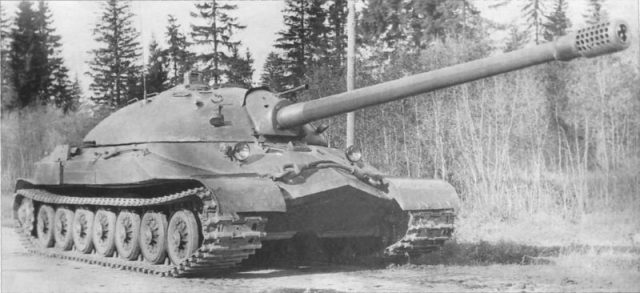
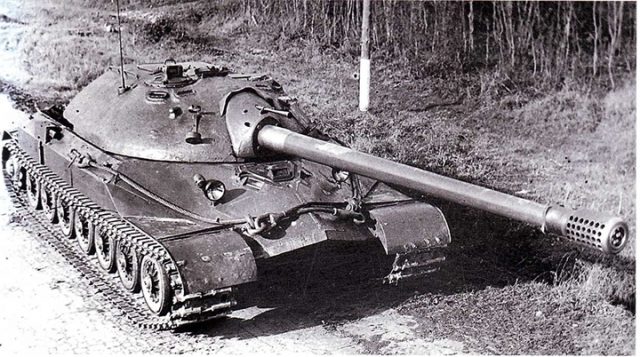
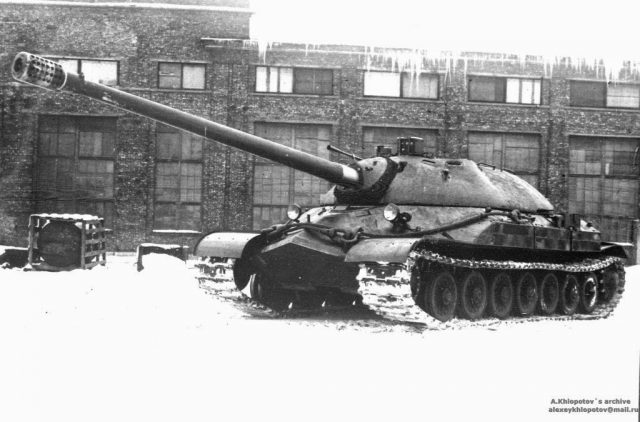
Photo: – Alexey Khlopotov
Fate
After the initial factory tests, the prototype tanks were handed over to the State Commission. The test drivers were famously fond of how the IS-7 handled. Reporting that it would respond to the smallest adjustment with ease. The tests were not without incident, though.
During one of the trials, an IS-7 caught fire, despite both sets of internal extinguishers firing, the fire continued to burn resulting in the abandonment of the vehicle and its complete destruction. The cause of the fire was thought to have originated with the weight-saving plastic lined canvas fuel tanks. Quite understandably, these were deleted in later versions.
Though it was liked and generally thought to be a good vehicle, the governing bodies refused to accept it into mass production. The official reasons are not known as to it was rejected. As such, the IS-7 would never enter service, with its successor, the IS-8, later known as T-10, proving to be a more flexible vehicle and able to better meet the needs found on the now fast moving battlefields. It served from 1953 to 1996.
Only one IS-7, built in 1948, survives today and is currently on display at the Kubinka Tank Museum.
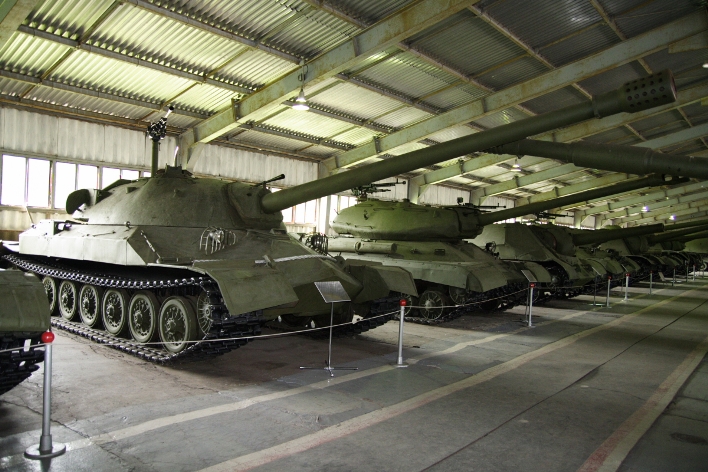
The IS-7 as it stands today in the Kubinka Tank Museum, alongside the IS-4.
Planned Variants
Object 261
While work was ongoing with the IS-7, plans were drawn up for a self-propelled gun variant based on the IS-7’s hull. There were 3 planned versions, the Object 261-1, -2 and -3. The 261-1 was a closed type with the fighting compartment on the bow end of the vehicle. It was armed with a 152 mm (6 in) M-31 gun. The configuration was similar to the ISU series.
The 261-2 had a rear mounted open fighting compartment. For this version and the following, the chassis was reversed, meaning the drive wheels were now at the front of the vehicle. What was the IS-7’s front was the 261-2’s rear. It was armed with a long-barreled M-48 152 mm (6 in) gun. The Object 261-2 was later redesignated Object 262.
The 261-3 had the same configuration as the 261-2/262, but was up-gunned with the naval derived 180 mm (7.09 in) MU-1 gun, also known as the B-1-P. Despite them being Self Propelled Guns, designed to be behind the lines giving fire support, these vehicles were intended to be well armored, with armor 150 to 215 mm (5.91-8.46 in) thick. The vehicles didn’t go further than the scale model phase.
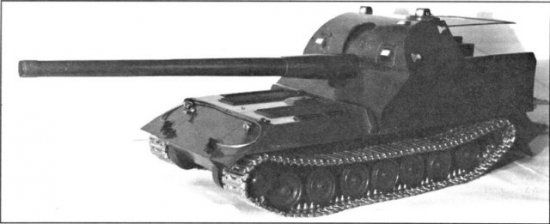
The small-scale mock-up of the Object 261-2/261-3. A Recoil-spade was also added to the rear.
Object 263
This was a tank destroyer variant, built on the same configuration to the 261. It had a rear mounted, semi-open fighting compartment. The main armament was the 130 mm (5.12 in) S-70A, with separately loading ammunition. This was a slightly modified version of the IS-7’s gun. The armor was up to 250 mm (9.84 in) thick, with a large, flat slab on the front of the vehicle, and two plates either side of the gun mantlet. The side armor was up to 70 mm (2.76 in).
As with the 261-2 and -3, the IS-7 chassis was reversed, a configuration similar to the British Archer. The driver was moved to the left of the gun. Whether the 263 would have had the same issue of the Archer’s engine heating the middle of the barrel and throwing off accuracy is unknown. Like the 261, the vehicle never went further than small scale models.
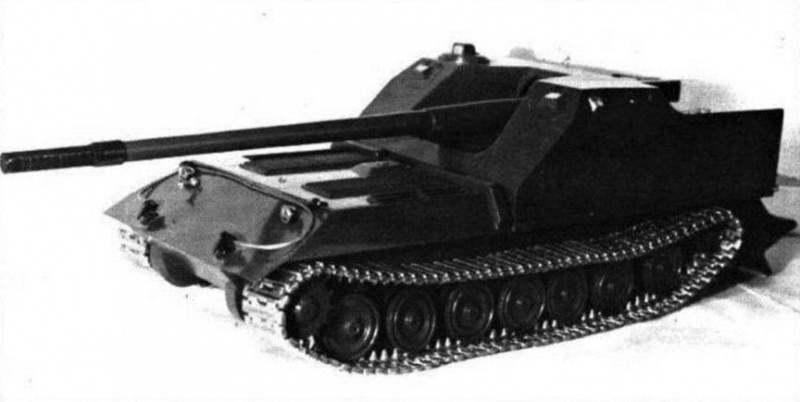
The small-scale mock-up of the Object 263. The 263 also saw the addition of a recoil-spade on the rear.
IS-7 (Object 260) specifications | |
| Dimensions (L-W-H) | 7.3 m x 3.3 m x 2.4 m (24ft 2in x 11ft 1in x 8ft 1in) |
| weight | 68 tonnes |
| Crew | 5 (driver, gunner, 2x loaders, commander) |
| Propulsion | 1050 hp 12 cylinder M-50T diesel engine |
| Suspension | Independant torsion bar |
| Speed (road) | 60 km/h (33 mph) |
| Armament | 130 mm (5.11 in) S-70 2x KPVT 14.5 (0.57) MGs 6x SGS 7.62 (0.3 in) MGs |
| Armor | Hull: 150 mm (5.9 in, upper glacis, angled at 60 degrees) – 100-120mm (3.94-4.72 in, lower glacis). Side armor is 150 mm (5.9 in) – 100 mm (3.94 in). Turret: 240-250 mm (9.45-9.84 in) |
| Total production | 7 prototypes |
Links & Resources
An article on the IS-7 on FTR
An article featuring the IS-7
The above link uses the following literature as the primary source: Heavy Soviet Post-War Tanks. Written by M. Baryatinsky, M. Kolomiets and A. Koschavtsev. “Armour Collection #3, 1996”
The IS-7 on mainbattletanks.czweb.org (Czech)
The IS-7 on warspot.ru (Russian)
English translation of the warspot.ru article

Cold War Tanks


































Cold war tanks posters

Cold War Main Battle Tanks

Cold War Soviet Army

